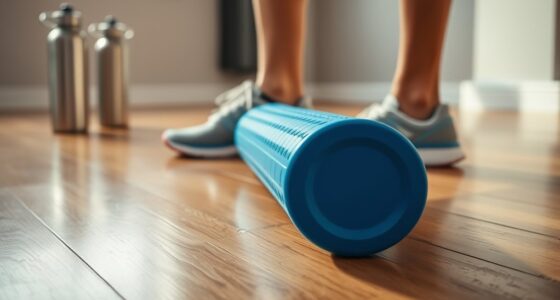To save your back in a home office, choose an adjustable chair with proper lumbar support and set it so your feet are flat and knees are at 90°. Position your monitor at eye level and keep your keyboard and mouse close to avoid strain. Take regular movement breaks and stretch often. Use ergonomic accessories like supportive pillows and adjustable stands. Keep your lighting balanced to reduce eye and posture fatigue. Discover more tips to create a truly comfortable workspace.
Key Takeaways
- Choose an adjustable chair with lumbar support to maintain proper posture and reduce back strain.
- Position your monitor at eye level and about 20 inches away to prevent neck and eye discomfort.
- Keep your keyboard and mouse at elbow height with wrists straight to minimize musculoskeletal stress.
- Incorporate regular movement, stretching, and short walks to improve circulation and reduce stiffness.
- Use ergonomic accessories like monitor stands, lumbar pillows, and wrist supports to enhance back support and comfort.
Choosing the Right Chair for Support and Comfort

Choosing the right chair is essential for maintaining proper support and comfort during long work hours. Start by adjusting the chair height so your feet rest flat on the floor, with your knees at a 90-degree angle. This position reduces pressure on your legs and promotes good circulation. Lumbar support is equally important; look for a chair that offers firm, adjustable lumbar support to maintain the natural curve of your lower back. Proper lumbar support prevents slouching and reduces strain on your spine. When seated, your hips should be slightly higher than your knees, and your back should be fully supported. Investing in a chair with customizable features guarantees you stay comfortable and avoid back pain throughout your workday. Additionally, selecting a chair with high-quality materials can enhance durability and overall comfort over time.
Optimizing Your Desk and Monitor Placement
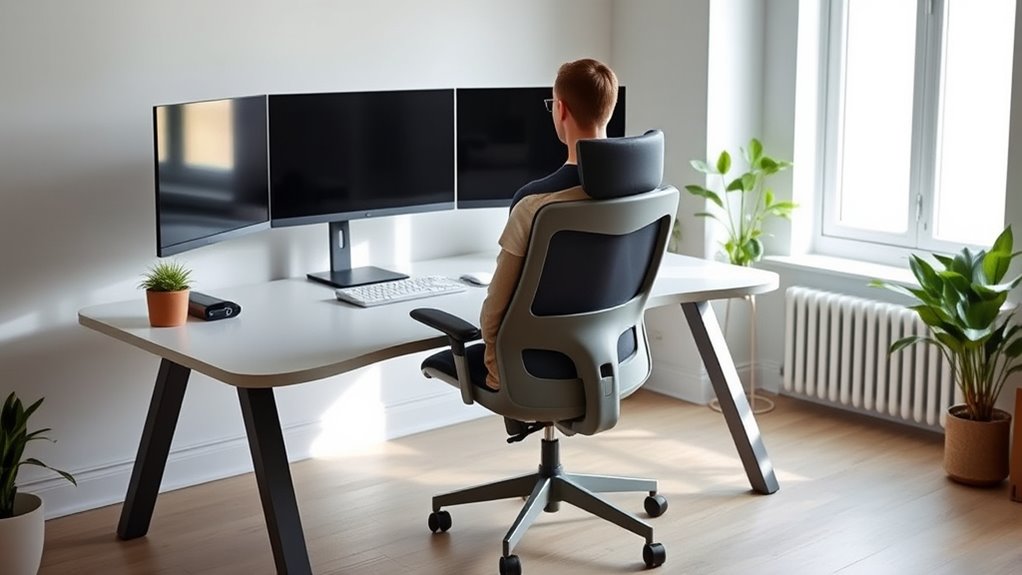
After selecting a supportive chair, the next step is to set up your desk and monitor for ideal comfort and productivity. Proper monitor placement reduces neck strain, so position it at eye level, about 20 inches away. Keep your desk organized to prevent clutter that causes stress and distraction. Use cable management solutions like clips or sleeves to keep cords tidy and avoid tripping or pulling. Arrange your workspace so frequently used items are within easy reach, minimizing unnecessary movement. Consider a dual monitor setup if you multitask often, but ensure they’re aligned at the same height. A clean, well-organized desk with managed cables promotes better posture, efficiency, and reduces back strain. Ensuring your workspace is ergonomically optimized can further enhance comfort during long work hours.
Proper Keyboard and Mouse Positioning for Reduced Strain
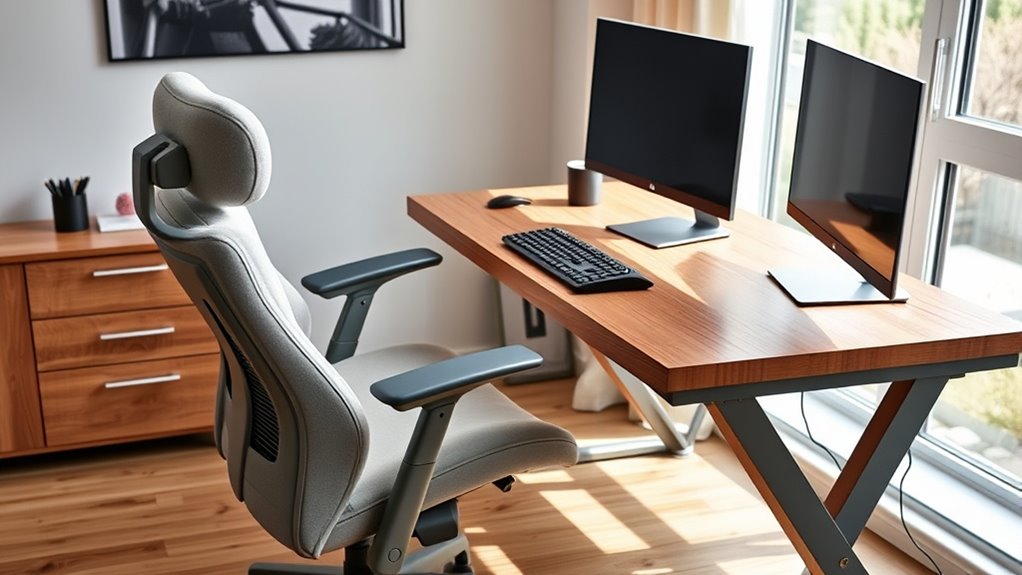
To reduce strain, keep your keyboard and mouse at elbow level so your arms stay relaxed. Make sure your wrists stay in a neutral position, not bent up or down, during use. Proper positioning can help prevent discomfort and improve your overall comfort while working.
Keep Devices at Elbow Level
Keeping your keyboard and mouse at elbow level is essential to prevent strain and promote good posture. When device placement aligns with your elbow height, you reduce shoulder tension and minimize wrist strain. To achieve this, adjust your desk height or use an ergonomic keyboard tray. Proper device positioning ensures your arms stay relaxed and your movements are natural. Additionally, maintaining the correct ergonomic setup can significantly improve comfort during long working hours. Below is a guide to help you set up your workspace effectively:
| Device Type | Ideal Placement | Benefits |
|---|---|---|
| Keyboard | At or slightly below elbow height | Less shoulder and neck strain |
| Mouse | Close to keyboard at same height | Reduced wrist stress |
| Monitor | Eye level, directly in front | Prevents neck discomfort |
| Desk Height | Adjust so elbows are at 90° | Promotes comfortable posture |
| Chair | Supports back, with feet flat | Enhances overall ergonomics |
Maintain Neutral Wrist Posture
Are you aware that maintaining a neutral wrist posture can substantially reduce strain during work? To achieve this, ensure your keyboard and mouse are positioned so your wrists stay straight and relaxed. Use wrist support if needed to keep your wrists in a neutral position, avoiding bending them up, down, or to the sides. Adjust your keyboard height so your forearms are parallel to the floor, and keep your mouse close enough to prevent reaching. Regularly check your wrist alignment, and take short breaks to stretch. Proper positioning minimizes strain and helps prevent repetitive stress injuries. Remember, small adjustments like wrist support and neutral positioning can make a significant difference in maintaining comfort and reducing fatigue throughout your workday. Incorporating ergonomic principles from hydrotherapy, such as water-based exercises, can also promote better circulation and reduce overall tension in your muscles.
Incorporating Movement and Stretching Into Your Routine
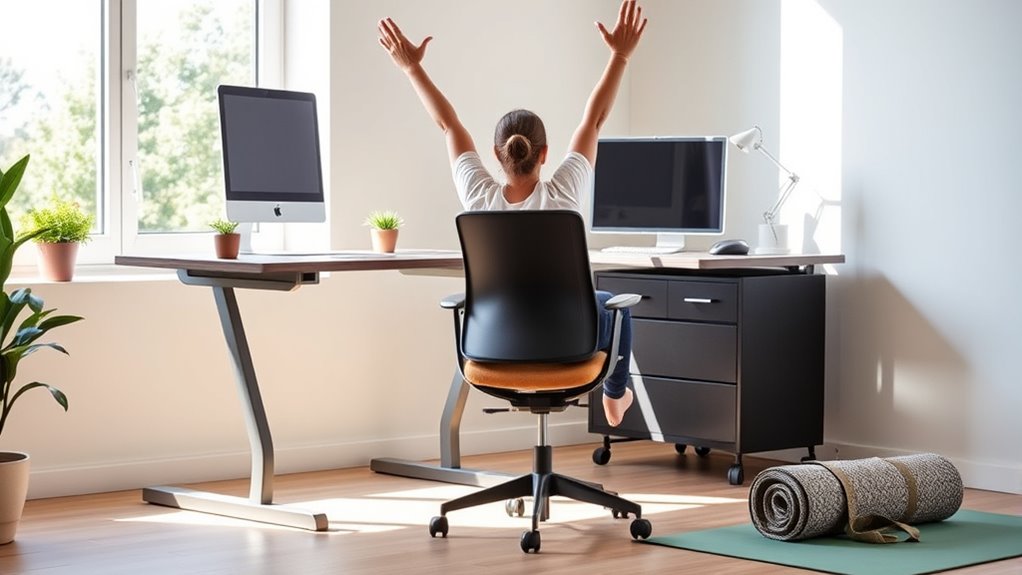
Since staying seated for long periods can lead to discomfort and reduced productivity, incorporating movement and stretching into your routine is essential. Taking regular movement breaks helps prevent stiffness and boosts circulation. Try incorporating stretching routines every hour to keep your muscles loose and reduce fatigue. During these breaks, stand up, stretch your arms overhead, or do gentle neck rolls. Use the table below to remind yourself of effective strategies:
| Movement Practice | Duration | Benefits |
|---|---|---|
| Stretching routines | 1-2 minutes | Relieve tension, improve flexibility |
| Short walks | 3-5 minutes | Increase circulation, energize |
| Desk exercises | 2 minutes | Strengthen muscles, reduce strain |
Additionally, incorporating ergonomic home office features can further enhance comfort and reduce the risk of strain while working.
Using Ergonomic Accessories to Enhance Support
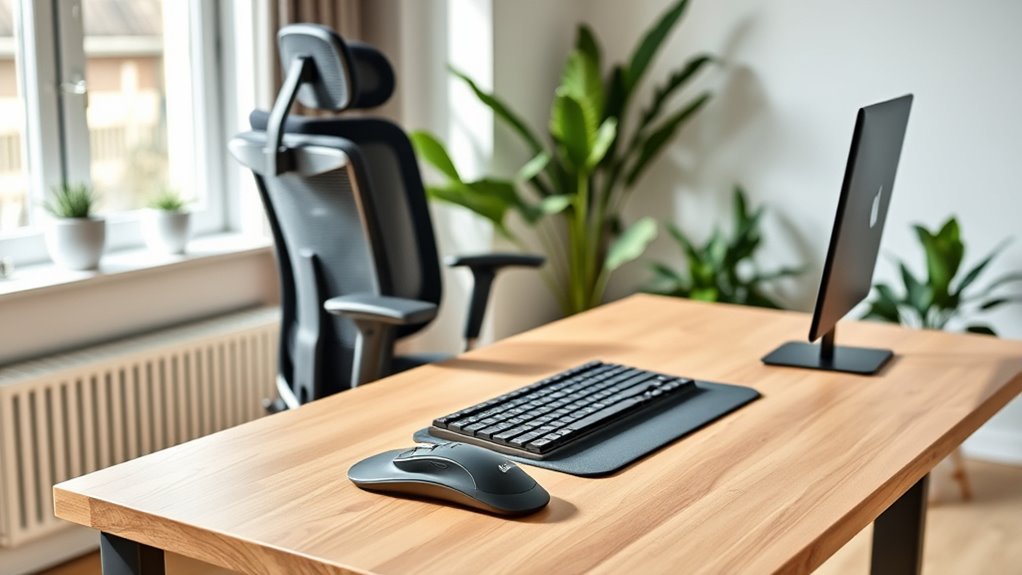
Using ergonomic accessories can make a big difference in your comfort and support throughout the workday. Adjustable monitor stands help you find the perfect eye level, while ergonomic keyboard placement reduces strain on your wrists. Supportive lumbar pillows keep your back properly aligned, preventing discomfort during long hours. Additionally, incorporating essential oils into your workspace can promote relaxation and reduce stress, enhancing overall comfort.
Adjustable Monitor Stands
Adjustable monitor stands are essential ergonomic accessories that help you customize your workspace for ideal comfort. They allow you to set your monitor to the perfect monitor height, reducing neck strain and promoting proper posture. With adjustable arms, you can easily reposition your screen to maintain a comfortable viewing angle throughout the day. This flexibility ensures you don’t have to hunch or strain forward, which can lead to back pain. By elevating your monitor to eye level, you encourage a more natural neck position. An adjustable monitor stand also helps create a clutter-free desk, keeping your workspace organized. Investing in this accessory makes it simple to adapt your setup as your needs change, ultimately supporting your back and overall ergonomic health. Additionally, incorporating proper ergonomic support can further enhance your comfort and prevent musculoskeletal issues.
Ergonomic Keyboard Placement
Proper keyboard placement plays an essential role in maintaining ergonomic comfort during your workday. You should position your keyboard to promote a natural keyboard layout, where your elbows stay close to your body and your wrists remain straight. Keep the keyboard at a height that allows your forearms to be parallel to the ground, preventing strain. Using ergonomic accessories like a wrist rest can support your typing posture and reduce tension. Avoid reaching forward or bending your wrists upward, as this can cause discomfort over time. Regularly adjusting your keyboard position ensures your shoulders stay relaxed and your hands stay aligned, helping you maintain a healthy typing posture. Small changes in placement can considerably reduce fatigue and prevent long-term musculoskeletal issues. Incorporating ergonomic technology into your setup can further enhance comfort and support during extended work periods.
Supportive Lumbar Pillows
Supportive lumbar pillows are essential ergonomic accessories that can substantially improve your sitting posture. They provide added lumbar support, helping your office chair maintain proper spinal alignment. When choosing a lumbar pillow, consider these key points:
- Ensure the pillow fits snugly against your lower back for maximum support.
- Opt for adjustable pillows to customize lumbar support as needed.
- Look for breathable, comfortable materials to prevent overheating.
- Position the pillow so your lower back maintains its natural curve during long work sessions.
- Selecting self-watering plant pots can be an example of incorporating ergonomic and sustainable solutions into your home environment, promoting overall well-being.
Using a lumbar support pillow correctly encourages better posture, reduces back strain, and minimizes discomfort. It’s a simple addition that makes your office chair more ergonomic and supports your back throughout the day.
Creating an Ideal Lighting Environment to Reduce Eye and Posture Strain
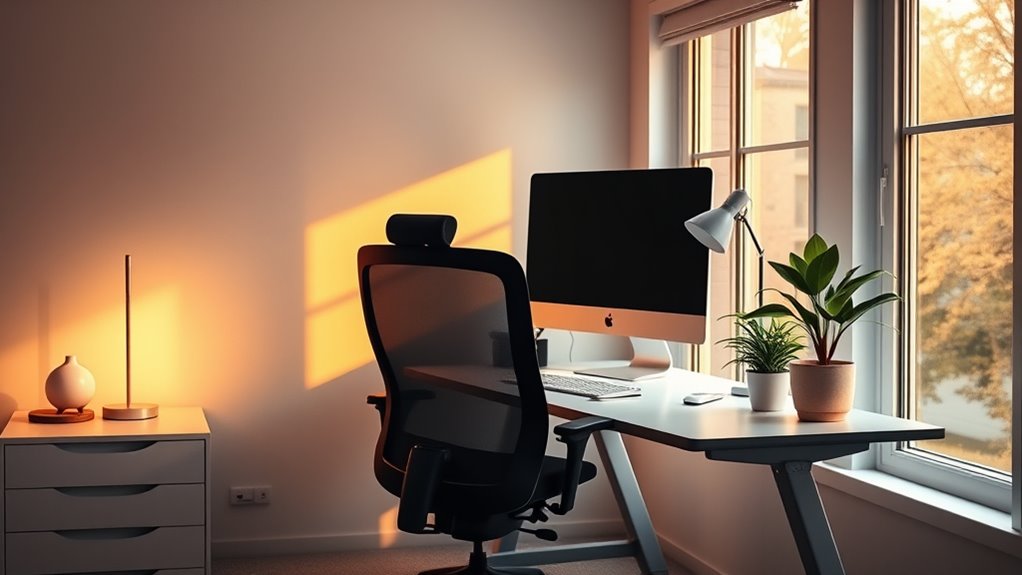
To minimize eye and posture strain while working from home, creating an ideal lighting environment is essential. Start by incorporating ample ambient lighting to evenly illuminate your space without creating harsh shadows. Use soft, diffused light sources, such as lamps with adjustable brightness or ceiling fixtures with dimmers, to reduce eye fatigue. Avoid glare by positioning your monitor away from direct light sources and using anti-glare screens if necessary. Natural light is ideal, so set up your workspace near a window but use curtains or blinds to control brightness levels. Consistent, balanced lighting helps your eyes focus comfortably and encourages good posture by preventing you from leaning forward or squinting. Additionally, understanding the regional legal resources available can help you access professional guidance if you’re navigating workplace ergonomics and safety regulations. This setup promotes a healthier, more productive work environment.
Frequently Asked Questions
How Do I Adjust My Chair for Different Tasks Throughout the Day?
When you switch tasks throughout the day, adjust your chair for comfort and support. Start by adjusting chair height so your feet rest flat on the floor and your knees are at a 90-degree angle. Then, reposition lumbar support to fit your lower back’s curve, providing proper support during tasks. These adjustments help prevent strain and keep you comfortable, whether you’re typing, reading, or taking a break.
What Are Signs of Poor Ergonomic Setup to Watch For?
Ever wonder if your workspace is secretly conspiring against your back? Signs of poor ergonomic setup include slouching, neck strain, and frequent discomfort. If you notice poor posture correction, like hunching over or uneven weight distribution, it’s time to reevaluate. A cluttered workspace organization can also cause constant reaching or awkward positions. Stay vigilant, adjust your chair, and keep your workspace aligned to avoid turning your home office into a pain zone.
Can Ergonomic Setups Help Prevent Long-Term Musculoskeletal Issues?
Yes, ergonomic setups can help prevent long-term musculoskeletal issues. When you use ergonomic accessories like adjustable chairs and monitor stands, you promote better posture awareness, reducing strain on your neck, back, and shoulders. By maintaining proper alignment and taking regular breaks, you lessen the risk of chronic pain and injury. Investing in ergonomic equipment supports your health, ensuring you stay comfortable and productive over time.
How Often Should I Take Breaks During Long Work Sessions?
Think of your work session as a marathon, not a sprint. You should take a break every 25 to 30 minutes to keep your energy and focus sharp. During these breaks, do stretching routines to loosen tight muscles. Incorporate ergonomic accessories like adjustable chairs or footrests to support your posture. Regular breaks prevent strain, helping you stay comfortable and productive throughout long work sessions.
Are There Specific Exercises to Strengthen Back Muscles While Working?
To strengthen your back muscles while working, incorporate core strengthening exercises like planks and bridges during breaks. Also, practice stretching routines such as shoulder rolls and spinal twists to relieve tension. These activities help improve posture, reduce strain, and support your back’s health throughout long work sessions. Consistently doing these exercises and stretches boosts your back’s resilience, making your ergonomic setup even more effective and comfortable over time.
Conclusion
Creating an ergonomic home office isn’t just about comfort—it’s about protecting your back and boosting productivity. Did you know that poor posture can lead to chronic pain and decreased work efficiency? By choosing the right chair, optimizing your setup, and incorporating movement, you can markedly reduce strain. Small adjustments make a big difference, so prioritize your comfort today. Your back will thank you for it, and you’ll feel more energized throughout your workday.




